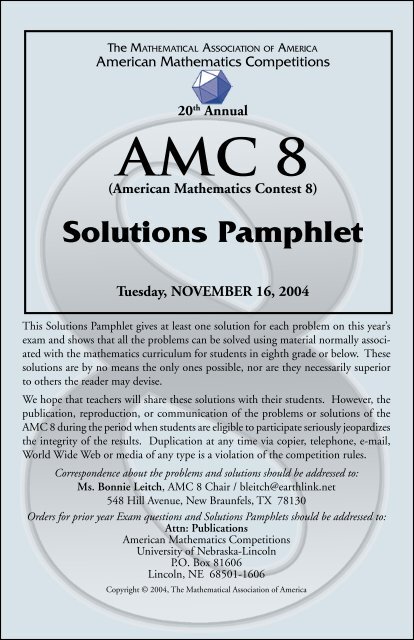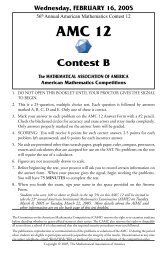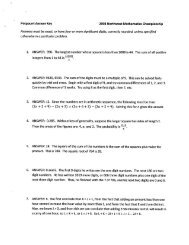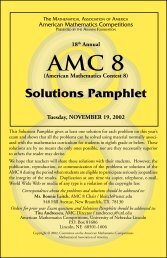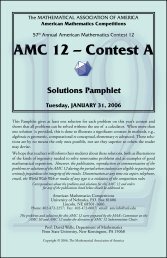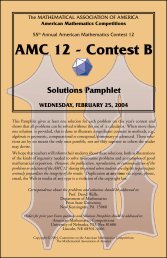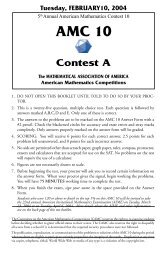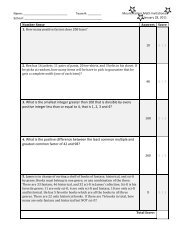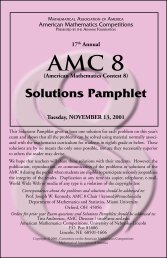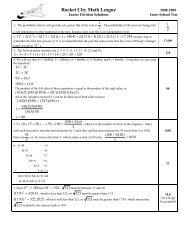Solutions Pamphlet
Solutions Pamphlet
Solutions Pamphlet
- No tags were found...
Create successful ePaper yourself
Turn your PDF publications into a flip-book with our unique Google optimized e-Paper software.
The Mathematical Association of AmericaAmerican Mathematics Competitions20 th AnnualAMC 8(American Mathematics Contest 8)<strong>Solutions</strong> <strong>Pamphlet</strong>Tuesday, NOVEMBER 16, 2004This <strong>Solutions</strong> <strong>Pamphlet</strong> gives at least one solution for each problem on this year’sexam and shows that all the problems can be solved using material normally associatedwith the mathematics curriculum for students in eighth grade or below. Thesesolutions are by no means the only ones possible, nor are they necessarily superiorto others the reader may devise.We hope that teachers will share these solutions with their students. However, thepublication, reproduction, or communication of the problems or solutions of theAMC 8 during the period when students are eligible to participate seriously jeopardizesthe integrity of the results. Duplication at any time via copier, telephone, e-mail,World Wide Web or media of any type is a violation of the competition rules.Correspondence about the problems and solutions should be addressed to:Ms. Bonnie Leitch, AMC 8 Chair / bleitch@earthlink.net548 Hill Avenue, New Braunfels, TX 78130Orders for prior year Exam questions and <strong>Solutions</strong> <strong>Pamphlet</strong>s should be addressed to:Attn: PublicationsAmerican Mathematics CompetitionsUniversity of Nebraska-LincolnP.O. Box 81606Lincoln, NE 68501-1606Copyright © 2004, The Mathematical Association of America
<strong>Solutions</strong> AMC 8 2004 11. (B) If 12 centimeters represents 72 kilometers, then 1 centimeter represents 6kilometers. So 17 centimeters represents 17 × 6 = 102 kilometers.2. (B) To form a four-digit number using 2, 0, 0 and 4, the digit in the thousandsplace must be 2 or 4. There are three places available for the remaining nonzerodigit, whether it is 4 or 2. So the final answer is 6.ORMake a list: 2004, 2040, 2400, 4002, 4020 and 4200. So 6 numbers are possible.3. (A) If 12 people order 1812 = 1 1 2times too much food, they should have ordered123 = 2 3 × 12 = 8 meals. 2ORLet x be the number of meals they should have ordered. Then,so1218 = x 12 ,x = 8.4. (B) When three players start, one is the alternate. Because any of the fourplayers might be the alternate, there are four ways to select a starting team:Lance-Sally-Joy, Lance-Sally-Fred, Lance-Joy-Fred and Sally-Joy-Fred.5. (D) It takes 15 games to eliminate 15 teams.6. (C) If Sally makes 55% of her 20 shots, she makes 0.55 × 20 = 11 shots. IfSally makes 56% of her 25 shots, she makes 0.56 × 25 = 14 shots. So she makes14 − 11 = 3 of the last 5 shots.7. (B) A 26-year-old’s target heart rate is 0.8(220 − 26) = 155.2 beats per minute.The nearest whole number is 155.8. (B) There are 7 two-digit numbers whose digits sum to 7: 16, 61, 25, 52, 34, 43and 70.9. (D) The sum of all five numbers is 5 × 54 = 270. The sum of the first twonumbers is 2 × 48 = 96, so the sum of the last three numbers is 270 − 96 = 174.The average of the last three numbers is 1743= 58.10. (E) Aaron worked 75 minutes on Monday, 50 on Tuesday, 145 on Wednesdayand 30 on Friday, for a total of 300 minutes or 5 hours. He earned 5 × $3 = $15.11. (C) The largest, smallest and median occupy the three middle places, so theother two numbers, 9 and 4, are in the first and last places. The average of 9and 4 is 9+42= 6.5.
<strong>Solutions</strong> AMC 8 2004 212. (B) The phone has been used for 60 minutes, or 1 hour, to talk, during whichtime it has used 1 3of the battery. In addition, the phone has been on for 8 hours8without talking, which used an additional24 or 1 3of the battery. Consequently,13 + 1 3 = 2 3 of the battery has been used, meaning that 1 3of the battery, or× 24 = 8 hours remain if Niki does not talk on her phone.13ORNiki’s battery has 24 hours of potential battery life. By talking for one hour,she uses 1 3× 24 = 8 hours of battery life. In addition, the phone is left on andunused for 8 hours, using an additional 8 hours. This leaves 24−8−8 = 8 hoursof battery life if the phone is on and unused.13. (E) Bill is not the oldest, because if he were, the first two statements would betrue. Celine is not the oldest, because if she were, the last two statements wouldbe true. Therefore, Amy is the oldest. So the first two statements are false. Thelast statement must be true. This means that Celine is not the youngest, so Billis the youngest. The correct order from oldest to youngest is Amy, Celine, Bill.ORThe possible cases for the three statements areI II III1 T F F2 F T F3 F F TCase 1 leads to a contradiction of statements I and II.Case 2 means Celine is youngest and neither Bill nor Amy is oldest, but onemust be oldest.Only case 3 is possible.Celine, Bill.The correct order from oldest to youngest is Amy,14. (C) To find the area, subtract the areas of regions A, B, C, D and E from thatof the surrounding square.Square: 10 × 10 = 100Region A: 3 × 5 = 151Region B:2 × 6 × 7 = 211Region C:2 × 1 × 3 = 1 1 21Region D:2 × 4 × 5 = 101Region E:2× 6 × 10 = 30The area is 100 − ( 15 + 21 + 1 1 2 + 10 + 30) = 100 − 77 1 2 = 22 1 2ORADCBEsquare units.
<strong>Solutions</strong> AMC 8 2004 3By Pick’s Theorem, the area of a polygon with vertices in a lattice is(number of points inside) +In this case, the area is 21 + 5 2 − 1 = 22 1 2 .number of points on boundary215. (C) The next border requires an additional 6 × 3 = 18 white tiles. A total of24 white and 13 black tiles will be used, so the difference is 24 − 13 = 11.− 1.16. (C) Because the first pitcher was 1 3full of orange juice, after filling with waterit contains 200 ml of juice and 400 ml of water. Because the second pitcher was25full of orange juice, after filling it contains 240 ml of orange juice and 360 mlof water. In all, the amount of orange juice is 440 ml out of a total of 1200 mlor 4401200 = 1130of the mixture.17. (D) The largest number of pencils that any friend can have is four. There are3 ways that this can happen: (4, 1, 1), (1, 4, 1) and (1, 1, 4). There are 6 waysone person can have 3 pencils: (3, 2, 1), (3, 1, 2), (2, 3, 1), (2, 1, 3), (1, 2, 3) and(1, 3, 2). There is only one way all three can have two pencils each: (2, 2, 2).The total number of possibilities is 3 + 6 + 1 = 10.ORThe possible distributions of 6 pencils among 3 friends are the following:1 1 41 2 31 3 21 4 12 1 32 2 22 3 13 1 23 2 14 1 1The number of possible distributions is 10.
<strong>Solutions</strong> AMC 8 2004 418. (A) Ben must hit 1 and 3. This means Cindy must hit 5 and 2, because shescores 7 using two different numbers, neither of which is 1 or 3. By similarreasoning, Alice hits 10 and 6, Dave hits 7 and 4, and Ellen hits 9 and 8. Alicehits the 6.OREllen’s score can be obtained by either 10 + 7 or 9 + 8. In the first case, it isimpossible for Alice to score 16. So Ellen’s 17 is obtained by scoring 9 and 8,and Alice’s total of 16 is the result of her hitting 10 and 6. The others scored11 = 7 + 4, 7 = 5 + 2 and 4 = 3 + 1.19. (B) The numbers that leave a remainder of 2 when divided by 4 and 5 are 22,42, 62 and so on. Checking these numbers for a remainder of 2 when divided byboth 3 and 6 yields 62 as the smallest.ORThe smallest whole number that is evenly divided by each of 3, 4, 5 and 6 isLCM{3, 4, 5, 6} = 2 2 × 3 × 5 = 60. So the smallest whole number greater than 2that leaves a remainder of 2 when divided by each of 3, 4, 5 and 6 is 62.20. (D) Because the 6 empty chairs are 1 4of the chairs in the room, there are6 × 4 = 24 chairs in all. The number of seated people is ( 34)24 = 18, and this isof the people present. It follows that23So there are 27 people in the room.18people present = 2 3 .21. (D) In eight of the twelve outcomes the product is even: 1 × 2, 2 × 1, 2 × 2,2 × 3, 3 × 2, 4 × 1, 4 × 2, 4 × 3. In four of the twelve, the product is odd: 1 × 1,1 × 3, 3 × 1, 3 × 3. So the probability that the product is even is 8 12 or 2 3 .ORTo get an odd product, the result of both spins must be odd. The probabilityof odd is 1 2 on Spinner A and 2 3on Spinner B. So the probability of an oddproduct is ( (1 2)2)3 =13 . The probability of an even product, then, is 1 − 1 3 = 2 3 .22. (B) Because 2 5of all the women in the room are single, there are two singlewomen for every three married women in the room. There are also two singlewomen for every three married men in the room. So out of every 2 + 3 + 3 = 8people, 3 are men. The fraction of the people who are married men is 3 8 .23. (D) The distance increases as Tess moves from J to K, and continues at perhapsa different rate as she moves from K to L. The greatest distance from homewill occur at L. The distance decreases as she runs from L to M and continuesat perhaps a different rate as she moves from M to J. Graph D shows thesechanges.
<strong>Solutions</strong> AMC 8 2004 524. (C) By the Pythagorean Theorem, HE = 5. Rectangle ABCD has area 10×8 =80, and the corner triangles have areas 1 2 × 3 × 4 = 6 and 1 2× 6 × 5 = 15. Sothe area of EF GH is 80 − (2)(6) − (2)(15) = 38. Because the area of EF GH isEH × d and EH = 5, 38 = 5 × d, so d = 7.6.25. (D) The overlap of the two squares is a smaller square with side length 2, sothe area of the region covered by the squares is 2(4 × 4) − (2 × 2) = 32 − 4 = 28.The diameter of the circle has length √ 2 2 + 2 2 = √ 8, the length of the diagonalof the smaller square. The shaded area created by removing the circle from thesquares is 28 − π ( √82)2= 28 − 2π.
TheAmerican Mathematics Contest 8 (AMC 8)Sponsored byThe Mathematical Association of AmericaUniversity of Nebraska – LincolnContributorsAkamai FoundationAmerican Mathematical Association of Two Year CollegesAmerican Mathematical SocietyAmerican Society of Pension ActuariesAmerican Statistical AssociationArt of Problem SolvingCanada/USA MathcampCanada/USA MathpathCasualty Actuarial SocietyClay Mathematics InstituteInstitute for Operations Research and the Management SciencesL. G. Balfour & CompanyMu Alpha ThetaNational Council of Teachers of MathematicsPedagoguery Software, Inc.Pi Mu EpsilonSociety of ActuariesU. S. A. Math Talent SearchW. H. Freeman & Company


